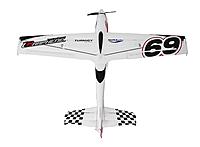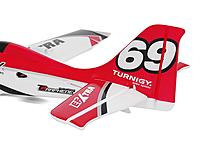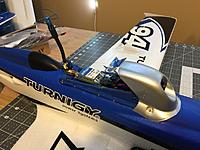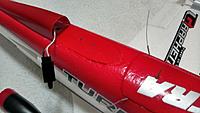| Thread Tools |
| This thread is privately moderated by PeterVRC, who may elect to delete unwanted replies. |
|
|
|
|
Thread OP
|
Build Log
EFXtra Racer - Durafly 975mm (Rating 10/10 !!)
Time for a new plane....
Seeing my 800mm Me-109 had a 'catastrophic incident' I decided to replace it with a Durafly EFXtra Racer, seeing that is a bit larger and can carry FPV with more weight leeway - or so I thought anyway. Mind you I repaired the Me-109 also.... hmmm. Well I did still need a Pylon Racer.... This is once again a 'new generation foamie' where they have added lots of plastic stuff and strengthening so that it is not just an almost all foam model aircraft that is weak and flexy etc. But this all comes at a cost of WEIGHT! It is quite costly (AU$210) for its size, but that is because it is the newer generation and more 'premium' quality, and also with higher than typical specs for the Power and RC system stuff. So I guess it is 'worth' what it costs, in relative terms to other RC models. The construction and finish is excellent - it seems to be another "HSD" model, which I am guessing by the many ways things have been done as per they do for their own models. I also comes with an "FPV Module" that replaces the battery hatch cover to then be an FPV setup. Too bad it LOOKS like an abortion gone wrong!! So ugly... I refuse to even consider using it! Once all assembled, I consider it HEAVY!! The AUW (unmeasured for now) is the weight that it should really be WITH a battery. It feels close to just right without the battery.... hmm. But that is the cost of having all those 'extras' that make it a strong, 'well built' model. And seeing it is intended to fly FAST, it will carry the AUW without a problem. But it might suffer when flying SLOW - like landing..... .... |
|
|
Last edited by PeterVRC; Jan 14, 2019 at 08:44 PM.
|
|
|
|
|
|
|
Thread OP
|
FPV Module
You have to build up the plywood framed FPV module that they supply, but I won't even bother doing that! Boy is it UGLY! And bulbous....
But at least it is easy for most users.... though they could have come up with a MUCH better design too! For my own FPV setup, it is going where the COCKPIT is... and will be way lower in profile and thus also be more streamlined. There is a bit of a trade-off required, as you want a BIT of height up off the fuselage 'top' so that you get a bit more useful content in the video frame. So I have to test heights, to get a bit of Wing seen in the video output. I am making mine Modular, in that a mounting plate is fixed to the fuselage and then you can replace the stock cockpit if you want, or bolt on FPV modules of either fixed camera, panning camera..... and if you really wanted it, a full pan/tilt setup - which I won't bother with as far as I can see for now. The "FPV Fixed Camera module" has a few height choices for the camera, so that you can tailor the view to what you might like. eg higher camera = more wing seen. Plus to suit whatever FOV lens you use. The Foxeer Arrow has about a 120deg FOV lens as it comes, but I will also try the 90deg FOV 'no distortion' lens in it. But with the lower FOV you pretty well need PAN ability, so I am also making a module that has panning for that option. .... ImagesView all Images in thread
|
|
|
Last edited by PeterVRC; Feb 19, 2017 at 05:32 PM.
|
|
|
|
|
Thread OP
|
Features
The EFXtra has a hefty sized 3536 motor of 1780kv. With a 60A ESC. You could say this is all the level of stuff a 1200mm 'normal' aircraft would commonly have, but it is all specced up higher in this so it can be FAST... a "Racer".
All in all I would also say you are getting a "1200mm foamie", paying about that cost and the typical components that would have, but just with less foam seeing it is smaller. That also means you end up with a similar AUW of a 1200mm aircraft..... All the control surfaces use ball joints, with Linkage Stoppers used on the Elevator and Rudder servo end, and a 'quicklink' at the Aileron servo ends. The quicklink being a much stronger method than the typical plastic clevis used on foamies. Thus all the surfaces are going to be highly reliable in linkage terms. The 60A ESC is sitting in after the Wing Seat, and this means all the leads are long - to go from the motor, rearwards to the ESC, and then back to the battery area up front. Because the plane is quite small this means they also are under the battery - using up battery area space - and also a tight squeeze under the fuselage/wing seat. All in all everything is quite tightly packed in to all fit ! The Tailplane/Elevator two halves use a plastic mounting assembly and are clipped together one plugged in - another HSD common trait. The clip struggles to actually clip shut properly, so it is a bit disconcerting to have to rely/trust in that it is really joined well and will STAY joined! You almost want to glue it all together to be 100% sure! It SEEMS it is holding properly, at least now, but I can see that it could also easily 'lose' the friction clip action it has. Little 'extras', like the plywood strips put into the Wing Tongue - to make sure the Tongue can't bend or break off, as per if it was just foam - are typical of the things done to assure it is a reliably working aircraft! Overall they have done a great job really. Seeing it is a hand-launcher.. belly lander... they added numerous underside protection bits!! A 'streamlined bulb' of a centreline skid..... a plastic skid plate under the nose.... a tail skid, which extends well down off the fuselage to keep that clear of the ground.... a 'streamlined bulb' under each Wing Tip area.... so they have done as much as can be done really! Plus the Aileron pushrods and control horns run out of the TOP of each Wing (not underneath). The Wing Tips have been clipped, with regards to the Prior EFXRacer version, and they have end plates fitted there. .... ImagesView all Images in thread
|
|
|
Last edited by PeterVRC; Feb 22, 2017 at 04:52 PM.
|
|
|
|
|
Thread OP
|
Cockpit/FPV Module
I finished off the Modular Cockpit assemblies.
The fuselage has the previously mentioned mounting plate - painted Cherry Red to match the plane. The original cockpit uses velcro to stick it onto the fuselage mounting plate. The various FPV modules use 2mm bolts to affix them to the fuselage mounting plate. I have not made the Panning FPV module version as I don't have a good 3.5g servo to design that around yet. The FPV Module power comes via a 4S Balance port plug, using its 3S pins, and modded to allow 4S and 3S balance port connectors to plug into it, thus it can be used for 3S or 4S flight batteries. At the Cockpit end it has a servo connector so that the FPV Modules can be fitted or removed easily. I should have used a micro JST 4 pin connector instead, to be much SMALLER, so I will change that at some stage soon. The 120deg FOV Foxeer Arrow lens does not show as much as I recall it 'did', it looks more like 90deg FOV to me. It is OK for a fixed FPV camera but it is more suited to panning. Even being mounted quite high, it does not show any Wing in the video frame. But it is still a totally viable flying view. The Foxeer Arrow has built in OSD showing the source Voltage, which in this case is 3S of either the 4S or 3S battery used. The information of Voltage, even just 3S of a 4S battery, is enough to determine the battery charge state, for a guide as when to take more care of battery demands and when it is time to land. .... ImagesView all Images in thread
|
|
|
|
|
|
|
|
Thread OP
|
FRsky Voltage Telemetry addon
FRsky have supported a simple form of input for Telemetry sensor purposes, in their D Series RXes, since they first came out.
This port is a simple A/D convertor that can accept a maximum Voltage of 3.3V - any higher and you can/will damage that port(!) - and it will report a Digital value of 0 - 255 for that range of 0v to 3.3v. To use it for a Voltage Telemetry system you just need to 'divide' down any higher Voltage you want to measure, to form that 3.3v maximum. You do this via a very simple Voltage Divider made from a few Resistors. For EG, if you want to measure up to 23v (6S) then you need to divide it down by 23/3.3 = 6.96.... so you choose Resistors to form that division ratio. Or for 4S, 17v / 3.3v = 5.15 Using close to that exact division ratio means you will get the highest resolution possible. But you want to lean to being equal to that OR a bit HIGHER.... never lower! Otherwise at the full Voltage it will go over the 3.3v limit. In an OpenTX/ER9X based TX system they support this FRsky Telemetry port system, and also give you an 'Offset' value to fine tune the value it will display - to make up for any Voltage Divider error. That Telemetry port can be used for ANY form of measurement, such as Current, RPM... anything.... that is made up to cover just that 0v to 3.3v range. There is a problem with this system, which it seems 'no one' ever accounts for... or at least is never mentioned or talked about.... There is an error in the 'zero' end of the scale, and in the TX you have an offset value which affects the entire range, but this then means it cannot fix an error in the zero end AND the higher 3.3v end also - because it cannot separate those two with only one offset factor supplied. When you have zero voltage at the port, it does not show zero at the TX. It can show as big an error as 1.0v. To fix this you need the Voltage Divider to be adjustable, so you can set the zero end via that, and then use the TX offset factor for the high end value. It ends up best to use a 4.7Kohm fixed resistor and a 10 turn potentiometer of 2Kohm, to form the required 4S Voltage Divider WITH an ability to fine tune the zero end. Via the 10 turn pot. So I made that up for the EFXtra and its D6FR Frsky RX.... so that I have real-time Telemetry of the battery state in flight. I have Telemetry in all my aircraft, but it is even more important in something that uses a lot of Power - something that has high battery load. This combination of quite small components ends up as a very small item to have connected from the battery balance port to the RX Telemetry port. And then I have Voltage Telemetry Display on the TX, plus Speech readout that can be switched on and off as required. You don't really have time to look down at displays when flying, so readouts via speech are far more useful! |
|
|
Last edited by PeterVRC; Mar 16, 2017 at 01:41 AM.
|
|
|
|||
|
Thread OP
|
Maiden flight and more.....
All went very straight-forwards and as you would HOPE for any flights... especially a maiden flight into the unknown!
The EFXtra just flew off into the sky perfectly fine right away. With about 60% throttle, on 4S, it easily maintained the launch height and climbed away shallowly, gaining speed into whatever climb you wanted from there. I used a 55mm CofG and that need a fair amount of DOWN trim to fly along level!! Though looking at the Elevator itself it is not much down trim physically. I would say that this Down Trim offset it needed also meant it flew pretty well hands off level flight when inverted too! Seeing when you go inverted the Down Trim becomes Up Trim.... and just the right amount to mean upright and inverted both do those level flight resultants. Whilst that is handy, it MIGHT still really be a bit tail heavy seeing it was extremely responsive to Pitch even with not much Elevator throw used. Though that did not seem to have any adverse effects in flight - I am just thinking that it MIGHT mean it is far more possible to encounter Accelerated Stalls if you used strong Pitch moves rapidly. Using a more nose heavy CofG negates that, but then you don't get that 'nice' equal upright and inverted behaviour either. For now it seems fine to use the 55mm recommended CofG...... As a "Racer"...... well it is fast. How fast I am not sure, but I am guessing the 160kph region. Though it is small and that makes it harder to visually know/decide. However fast it is, it is way faster than any 'normal' foamie. I am pretty sure it is a fair amount faster than my 1200mm Sea Fury Racer which does 140kph. It tracks very well - which anything moving through the air FAST will do anyway - but it is also 'skittish' and responds extremely fast to any control surface moves - so any 'micro moves' you do on the TX cause a notable and instant response in the EFX! I had 30% Expo and it still needed very delicate controls motions to form a smooth flying path. Any fractional 'slip' of the controls could be seen in that instant. At 951g it felt heavy for its size, but it flew totally fine. Again, airspeed - fast - makes up for many aspects, such as AUW. Fast means more lift anyway.... BUT, it also GLIDES extremely well, so this shows it has a lot of lift anyway. And all in all it easily carries that 'heavy feeling' 951g without a qualm. I had five flights on the day. Two with Turnigy Nanotech 4S 2200mAH 35C batteries and three with 4S 2200mAH 45C Graphene batteries. Both types seemed much the same results, but technically the Graphenes HAD to be stronger. I would think that at the high end Power ranges, where it is FAST and thus there is a LOT of drag, the higher Power of the Graphenes more just means that it gives you "2kph more".... seeing you need a LOT of Power to go not much faster then anyway. 5.0 min flights, using mainly 40%-50% throttle - as that is fast anyway, and using more Power doesn't give you a lot of speed increase per that extra power eaten up(!) - had the batteries come down at 3.71v to 3.75v per cell regions, and just faintly warm too. 5.0 mins is enough time to fly a fast plane and then have a rest anyway..... Landings were easy, and very much like landing a Durafly Vampire EDF jet. Both of those aircraft glide FAR better than you would expect! Pretty well double of what it feels their AUW would cause. It took me three landing before I could get it to be sliding to a stop just near to me, rather than passing by me by 10m to 20m !! And that was even into a fairly strong head wind when coming in at dead-stick from WAY out. All in all, it is a very good plane... very well built.... FAST.... and it does it all with great ease. And with its 'solid' (no freeplay) control surfaces it does it with high accuracy too. Oh, and all the underside SKIDS it has means there is no wear and tear on any foam from its belly landings, so after its five flights it still looked as new and as if it had never ever been flown yet! Of course if the ground/grass was TOO ROUGH then you could reach foam surfaces. But even on nice grass, raw foam gets 'burnt' due to friction, so all those skids are truly doing a great job! Pre-Maiden info and Flight 5 video: ....
|
||
|
|
|||
|
|
|
|
Thread OP
|
EFXtra - broken
As the flying days with the EFXtra went by, I pretty much formed a standard sort of routine of paths and manouevers to fly, as it is FAST and needs a bit of a plan to form a nice 'display'.
One of the neat things is it is 'razor sharp' and also does very axial rolls, which high speed means there is no much altitude loss as it Rolls around and through the 90deg 'low lift' points. This then means you can be more 'assured' it will do the axial rolls with little effort required..... This promotes doing Rolls LOWER.... as they are 'safe'... well at least pretty safe. And the lower a Roll is done the more impressive it is! Better background reference.... seen better.... and a known element of danger.... And you really got to do it a lot 'easier' than most aircraft can do it anyway! Over the days out flying it I was coming lower and lower to do long slow axial rolls. These are the most impressive to do. (bar doing hesitations rolls! 4 or 8 point!) I was down to doing them at about 15 feet with 'total safety'..... and verging on moving down to around a bit over head height - maybe 10 feet. At the park that has less room, I took off on flight one of the day.... did some typical up and down passes with 'loop turns' (whatever they are really named)... and then within the first minute came through to do a slow axial roll. Normally I would do various rolls up high, and do any initial 'low' ones more like 20 feet. But I went straight to 15feet for the very first one. I don't know what happened... what caused the big high speed crash!! By inverted all was fine - but that is where it unfolded.... it began to 'dive' from the 180deg roll point. Easy... just use DOWN Elevator and fly UP out of it... This is the unknown part... seeing it erased the dive angle... then arced a BIT upwards... but then DIVED to the ground and hit at about 30deg angle approx! Very fast... probably 120kph region! No hat cam!!! Imbecile! Golden Rule - Video EVERY flight of EVERY aircraft - just in case! Now I can't review it.... (or post it) I THINK I maintained the Roll as I did the "Quick, go to a lot of DOWN Elevator"... so as it rolled over to upright THEN it resumed the dive process! Brain fade I am guessing.... Either that or my new Taranis M9 Gimbal had a glitch.... or the just upgraded OpenTX V 2.2N363 version.... Who knows.... but the EFXtra broke..... Because it hit at 30deg approx, BUT with leveled wings (phew!!) the majority of the impact force went into breaking the nose off just ahead of the wing seat. The prop broke both blades, but the impact angle must have closely matched the spinner 'slope' angle and thus the motor shaft was totally fine. No impact energy went through the motor. it was all into the nose and snapping that off. The wing broke in 4 places... all in the middle seat area... one right through from leading edge to trailing edge, but the main spar remained intact and kept it together as one piece! It tore the wing bolts through the wing mounting plates, but didn't bother the fuselage captive nut parts of it. So it was the BEST possible high speed crash manner/path you could have!! About 7 major, but totally clean, breaks! And also no foam compression - which can be a pain to 'stretch' back well. At home... 3 hours later.... all back in one piece... with a few extra carbon fiber strips across joints to assure the high speed high stress EFXtra won't break apart in flight! That was VERY lucky.... and could have been massively worse! eg If it hit a wing first etc! I even forgot to take pictures when collecting the parts... and even on the table at home... That was a very bad job at 'recording' it all... from lack of video to lack of pictures! THAT aspect of it all is more annoying than the crash! (seeing the EFXtra itself has come out in great shape in the end). No more low slow axial rolls !!! A 20 feet minimum height limit for those now!! |
|
|
Last edited by PeterVRC; Mar 16, 2017 at 02:07 AM.
|




















































